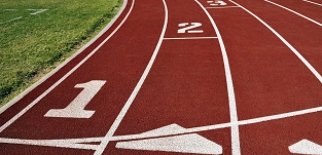Many schools are preparing for sports day. This gives a good reason for having a themed day with all learning around a context and obviously 'Sport' would be a great context at the moment, particularly with the Commonwealth Games starting in Glasgow on 23rd July.
We have had such a great few weeks of sport with the football World Cup in Brazil, the Tour de France Grand Depart from Yorkshire, a great Wimbledon final and now the Commonwealth Games in Glasgow 23rd July to 4th August.
There are so many possible maths links to sports with measuring being the most obvious. Distance and time in particular can involve lots of practical outdoor activities - running, throwing, jumping. There is an abundance of sports statistics for data handing and the Olympic website is a good place to find information.
EYFS/ KS1
The numbers 1-8 on the start of a track are a great opportunity to do some body maths. If you don't have a track outside at school, use tape to make lanes on the classroom floor and write the lane numbers on A4 and stick those down too.Cardinal numbers
Ask different children to...
• stand on the number 8
• stand on the number one more than 5
• stand on a number less than 4
• stand on a number between 3 and 6
As a challenge ask a child to give instructions like these, they choose a child and ask them to stand on a number - but they cannot say that number. You can have ' 1 less than', '2 more than', 'between ... and ...' written on the board to help.
Place one child on the number 4, ask the class to give different ways to show the place of that number.
1 more than 3, 2 less than 6, between 3 and 5 ......
Ordinal numbers
Group children into 8 teams of 3-4. Give each team a large dice. One team member 'the runner' stands on a start number 1-8 on the track.
The teams take turns to roll the dice and shout the number, their 'runner' on the track takes this number of steps forward.
Let each team roll 2-3 times and then see the position of each 'runner' using first, second,... eighth.
Numbers at the 2014 Glasgow Commonwealth XX Games
This is the twentieth games - XX Commonwealth Games. It is the third time it has been held in Scotland, Edinburgh hosted the Commonwealth games in 1970 and 1986.
6500 athletes from 70 countries will take part in 17 sports over 11 days.
The Queen's Baton Relay began on 9th October 2013 and will travel for 288 days, over 118,000 miles and will spend 1-4 days in each Commonwealth nation or territory. It will end in Glasgow at the opening of the Games on 23rd July 2014.
KS2
Talk about the 400m running track. You could measure out 400m with a trundle wheel and get the children to run this distance, it always seems longer than you might imagine by looking at a picture of a track.
Calculation
• Calculate how many times you would have to run round the track for each of the running distance events above.
• In the relay with a team of 4, each athlete runs 100m (4 x 100m relay) passing a baton to complete one 400m circuit of the track. How many different number of athletes in a relay team can you find to compete in a 400m race - all athletes must run the same distance, each distance must be a whole number.
[100 x 4m, 8 x 50m, 2 x 200m...]
Statistics, time, rounding and ordering decimal numbers
Here is a link to the times of the 100m mens final in 2012 London Olympic games.
• Draw a block graph and ask questions about the data.
They will have to think carefully about the scale they use for time - as there is less than half a second between the top 7 runners!
• Round each of the times to the nearest tenth of a second, then round each time to the nearest whole second.
An interesting extension to this is to get your class into groups of 6-8.
• Use a stop-watch to time each other run 100m and record the results.
• Use these results to draw block graph showing the times of their teams.
Does the time scale on the graph need to change?
What is the difference between the fastest in their group and the time of Usain Bolt?
• Once the times of the 100m finalists were rounded to the nearest whole second 7 runners had times of 10 secs. Set a start line, then mark and measure the distance each member of the group can run in 10 seconds.
They will have to think about how to set up this task to mark the distance a runner is at after 10 seconds. Have a few trials to see the best method - perhaps blowing a whistle when 10 seconds is timed and marking the positions with a beanbag.
Related articles
Plan your own Olympic maths activities
Start with sports data or start with a maths problem - adapting 'Keiron's cats'
Maths, the Olympics and NRICH
A great website with lots of problem solving activities linked to sports day and the Olympics
A little sporting logic for the olympics
Solve this maths mystery, use the six clues to find who played which sport.




